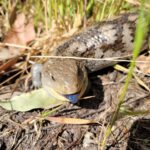Common Blue-tongued Lizard
Tiliqua Scincoides
Blue-tongues are named after their bright blue fleshy tongues that they stick out when alarmed to frighten off predators.
DESCRIPTION
Common Blue-tongue Lizards (also known as Blue-tongues) are the largest members of the skink family, and like all lizards, need help from the sun to maintain a constant body temperature. This means they can often be seen warming themselves in sunny areas before foraging for food during the warmer parts of the day, then sheltering at night under large logs and leaf litter. This basking can lead to tragedy if they bask on the warm roads because they are slow moving. During colder months they are mostly inactive, remaining deep in their shelter sites. They inhabit a wide variety of ecosystems, tending to live in open country with lots of ground cover such as tussocky grass and leaf litter. They can grow up to 60cm in length, of which about 36cm is head and body.
Blue-tongues are named after their bright blue fleshy tongues that they stick out when alarmed to frighten off predators. If the threat does not go away, they may hiss and flatten out their bodies, making themselves look bigger. They are not venomous but may bite if handled roughly and may drop their tails. The tail stump heals rapidly and a shorter regenerated tail grows back after a while.
They have silvery grey to brown smooth scales, with distinct dark stripes running across their body and tail. Their underbelly is usually a light grey colour. Blue-tongues have a broad triangular head that is wider than the neck. Their eyes are reddish-brown to grey and there is a broad black strip that runs from the eye to their neck.
These striking lizards are not very agile, so the animals they eat are mostly slow-moving and include a variety of insects, beetle, snails, wildflowers, native fruits and berries. In addition to using their nose to smell, they have an organ called a ‘Jacobson’s Organ’ on the roof of their mouths that they use to sense chemicals emitted by their prey. This helps them to detect and capture their prey. They have strong teeth and jaw muscles to crush food such as snails and beetles.
They mate between December and April, and three to four months later the females give birth to live young (this is very unusual in lizards). The embryos develop in the female’s oviduct with the help of a placenta. At birth, the young eat the placental membrane and within a few days shed their skin for the first time and disperse shortly after. Around 10 young are born, measuring 130-140mm in length and weighing 10-20g. They are long-lived, and captive animals have been reported to live more than 20 years.
Many threats face Blue-tongues, including large predatory birds (such as Laughing Kookaburra and Brown Falcons) and large snakes, feral cats and dogs. As well, since they eat snails and slugs and are useful in the garden, you can keep them safe by installing rockeries and horizontal pipes for hiding in, with access to lawns for basking. It’s important to not use baits and poisons. At Wildlife Wonders, look out for these beautiful lizards at the edges of the paths, basking in the warm sunshine.
Want to see common blue-tongued lizards at Wildlife Wonders? Book here!






